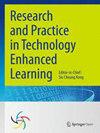一种适应学习者错误的力学辅助问题呈现系统的课堂实施
IF 3
Q1 EDUCATION & EDUCATIONAL RESEARCH
Research and Practice in Technology Enhanced Learning
Pub Date : 2023-11-13
DOI:10.58459/rptel.2024.19026
引用次数: 0
摘要
基于错误的模拟(EBS)是一个学习支持框架,它将学习者的错误可视化,并鼓励尝试和错误。但是,当学习者陷入困境时,EBS很难帮助他们摆脱困境。此外,给一个被卡住的学习者一个正确的答案可能会干扰EBS所面向的试错活动。因此,有必要在试错活动中鼓励学习者,而不是给他们正确的答案。在这项研究中,我们证实了我们的系统的有效性,该系统基于传统的力学EBS,并根据学习者的错误提供自适应辅助问题。此外,我们分析了基于力的自我克服来评估我们的系统。自我克服是指学习者可以在没有教师干预的情况下通过使用系统来消除错误。如果自我克服发生了,学习者可以继续对辅助问题进行试错,即使他们被卡住了。为了验证该系统的学习效果,我们对86名初三学生进行了课堂实施,并对结果进行了分析。来自练习的系统日志显示了自我克服正在发生,并且它反映在测试结果中。本文章由计算机程序翻译,如有差异,请以英文原文为准。
Classroom implementation of an auxiliary problem presentation system for mechanics adapted to learners’ errors
Error-based Simulation (EBS) is a learning support framework that visualizes learners’ errors and encourages trial and error. However, when a learner is stuck, EBS has difficulty in helping them overcome the impasse. Additionally, giving a correct answer to a learner who is stuck may interfere with the trial-and-error activity that EBS is oriented toward. Therefore, it is necessary to encourage learners during trial-and-error activities without giving them correct answers. In this study, we confirm the effectiveness of our system, which is based on conventional mechanics EBS and provides adaptive auxiliary problems based on learners’ errors. Furthermore, we analyze force-based self-overcoming to evaluate our system. Self-overcoming means that the learner can eliminate errors by using the system without the intervention of the teacher. If self-overcoming occurs, the learner can continue trial-and-error with the auxiliary problems, even if they are stuck. To verify the learning effectiveness of such a system, we conducted a classroom implementation with 86 third-year junior high-school learners and analyzed the results. The system logs from the exercises revealed that self-overcoming was taking place, and that it was reflected in the test results.
求助全文
通过发布文献求助,成功后即可免费获取论文全文。
去求助
来源期刊

Research and Practice in Technology Enhanced Learning
Social Sciences-Education
CiteScore
7.10
自引率
3.10%
发文量
28
审稿时长
13 weeks
 求助内容:
求助内容: 应助结果提醒方式:
应助结果提醒方式:


